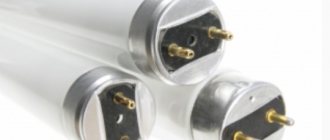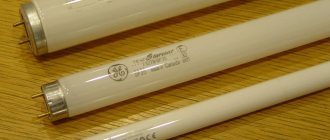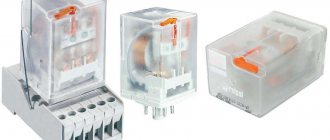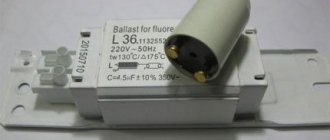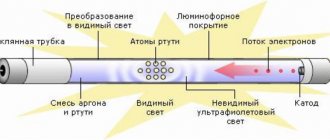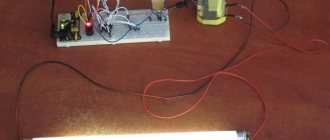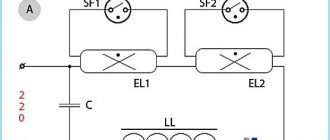Modern fluorescent lamps (FL) do an excellent job of lighting large residential, work and technical premises and can reduce overall electricity consumption by 50-83%, thus reducing utility bills.
In this article, we will consider the operating characteristics of LLs, their design, and analyze the main advantages and disadvantages in comparison with other types of lighting devices. In addition, we will provide thematic photos and diagrams, as well as videos about the operating principle of fluorescent light bulbs and the features of their application.
Device and principle of operation
The functioning of products is based on the process of luminescence. The inside of the flask is coated with a phosphor that “absorbs” ultraviolet radiation and produces a glow in the spectrum visible to the human eye. To form ultraviolet rays, mercury or an inert gas is used, which is filled with a flask. When an electric charge passes through, drops of mercury begin to evaporate, producing radiation.
The products consist of a flask with electrodes, one or two bases and ballasts (ballasts). The last component can be built-in or remote.
In turn, the ballast contains a choke and a starter. The first device limits the current supply, lowering the voltage to operating voltage, and the second accelerates the process of heating the electrodes and the light bulb reaching the specified mode.
The inclusion of the product is ensured by implementing the following steps:
- heating of electrodes;
- giving an impulse for ignition;
- reduction and stabilization of voltage.
How does a fluorescent lamp work?
The main part of a low-pressure fluorescent gas-discharge lamp is a glass tube, which is given different shapes:
- linear - up to 1.5 m long, to obtain uniform diffuse lighting;
- spiral and U-shaped - for compactness;
- round (ring-shaped) - for decorative lamps.
Fluorescent lamp OSRAM 22W G10q 1350lm 4000K 230V ring
On both sides of the tube, coated with phosphor on the inside, there are electrodes, between which an arc discharge occurs when voltage is applied. The combustion of the arc inside the flask is maintained by an inert gas, usually argon, with the addition of mercury vapor. Mercury atoms, under the influence of a flow of electrons, emit rays invisible to the eye in the ultraviolet range. Under their influence, the phosphor located on the inner walls of the flask begins to emit visible light. The color temperature of a fluorescent lamp depends on the composition of the phosphor.
The gas environment inside the flask in a cold state has high electrical resistance. To ignite a gas-discharge arc when turned on, it is necessary to apply a high voltage pulse to the electrodes. A burning arc, on the contrary, has a negative differential resistance and to prevent a short circuit, a ballast is needed, connected in series with the electrodes. Modern lamps use electronic ballasts - electronic ballasts, which control the ignition and burning of the arc. And compact lamps with a screw base already have electronic ballasts built directly into the body, so they can be connected directly to a 220 V network.
In old-style luminaires, EMPA is used as ballast - an electromagnetic device for starting and regulation based on an inductive reactance choke and a neon starter.
Electronic ballasts have a number of advantages over electronic ballasts:
- eliminates flicker of light noticeable to the eye due to the lamp being supplied with high frequency current;
- reduces electricity consumption - up to 25%;
- helps extend lamp life.
Therefore, they are often purchased to upgrade previously installed luminaires with electromagnetic chokes.
Electronic ballast electronic ballast Navigator 94 449 4*18W
Classification
There are several criteria for classifying such electrical products. They can:
- emit daylight or white light;
- have different widths of the transverse tube (as it increases, the power of the lamp increases, on which the possible area of the illuminated room depends);
- have several contacts;
- produced with or without a starter (in the second case, the model is more economical);
- work from a network of different voltages;
- differ in shape (arc, spherical or spiral).
Marking
In Russia and abroad, different standards for labeling these products are used.
International marking
American manufacturers of fluorescent lamps label their products according to the FxTy scheme, where
- F - fluorescent (translated from English as “luminescent”);
- x—power (W);
- T - tubular (translated from English - “tubular”), may be of a different shape;
- Y - diameter 1/8 inch.
After this, the color of the device is indicated in Latin letters:
- WW - warm white;
- CW - cool white;
- N - neutral;
- D - daytime;
- WWX - warm white with high color rendering;
- CWX - cool white with high color rendering;
- BLB - ultraviolet.
At the end of the line, letters are added indicating the features of the product. These may be the following designations:
- RS - quick start;
- IS - instant start;
- HO - high efficiency.
As you can see, manufacturers indicated the main technical characteristics in the product labeling.
Russian markings
Domestic manufacturers apply different markings using Cyrillic letters:
- "L" - lamp;
- "D" - daylight;
- "B" - white;
- "T" - warm;
- "E" - natural;
- "X" - cold.
If the model is compact, then the letter “K” is used at the beginning of the marking. Fluorescent lamps with improved color rendering have the letter “C” at the end of the line. Sometimes you can find two such letters, which indicates the best color rendition.
The first number in the marking describes the color rendering (must be multiplied by 10), the next two - the color temperature (in Kelvin) divided by 100.
Nuances of choosing fluorescent lamps
If you are looking for a replacement lamp, then first of all you need to determine the models that are compatible with your existing lamp. To do this, look at the instructions for the lighting device, where the type and parameters of suitable light sources are usually indicated. If this is not possible, unscrew the old light bulb and use the markings on it to select a new one with similar parameters. If there are no markings, use the illustrations in this article to visually identify the type of lamp.
For the compatibility of the lamp and luminaire, the type of base and dimensions of the bulb are important. You can make sure that the standard size of the base fully corresponds by taking simple measurements - the numbers in its designation are equal to the distance in millimeters between the contact pins or the diameter of the screw part.
To get the maximum effect when using lighting devices, when choosing lamps for them, you must take into account all the basic parameters:
- luminous flux - measured in lumens. The higher this indicator, the larger the area the lamp can illuminate;
- power - characterizes, first of all, electricity consumption and indirectly the intensity of the glow, which largely depends on the production technology used;
- color temperature is an important parameter that affects the comfort of a long stay in a room with artificial lighting, performance, fatigue and emotional background;
- color rendering - by choosing a lamp with good color rendering, you can visually change your usual surroundings, making the colors brighter and more saturated.
In the Maxidom online store you can select suitable fluorescent lamps and other lighting products and purchase goods at a favorable price with delivery.
Appearance
There are two main types of fluorescent lamps in appearance.
Linear type
The design involves the use of an elongated flask (tube). Area of application: public and industrial facilities (for example, shopping or sports halls). The marking contains the letter "T".
Compact type (CFL, or “housekeepers”)
Designed for domestic use. They are characterized by a curved flask resembling a spiral. Divided into two subcategories:
- with a pin base - the marking uses the letter G, and the numbers indicate the distance between the pins;
- with a standard base (similar to incandescent lamps) - letter E, numbers indicate the diameter of the base.
Pin CFLs without a choke are used in table lamps.
Features of compact LLs
Compact-type LLs are hybrid products that combine some of the specific distinctive features of incandescent lamps and the characteristics of fluorescent lamps.
Thanks to advanced technologies and expanded innovative capabilities, they have the small diameter and medium-sized dimensions characteristic of Ilyich light bulbs, as well as a high level of energy efficiency characteristic of the LL line of devices.
Compact-type LLs are produced for traditional sockets E27, E14, E40 and are actively displacing classic incandescent lamps from the market by providing high-quality light with significantly lower power consumption
CFLs are in most cases equipped with an electronic choke and can be used in specific types of lighting fixtures. They are also used to replace simple and conventional incandescent lamps in new and rare lamps.
Despite all the advantages, compact modules have such specific disadvantages as:
- stroboscopic effect or flickering - the main contraindications here concern epileptics and people with various eye diseases;
- pronounced noise effect - during prolonged use, an acoustic background appears that can cause some discomfort in a person in the room;
- odor – in some cases, products emit pungent, unpleasant odors that irritate the sense of smell.
The last position is more often observed in nameless crafts of Chinese origin, and even branded devices made in accordance with all the rules and modern requirements often suffer from the first two. We have given the rating of the best CFL manufacturers in this article.
Advantages and disadvantages
Advantages of fluorescent lamps:
- More durable compared to incandescent lamps (service life in hours is 10–20 times higher), but only in the absence of significant voltage drops.
- High light output.
- Variety of colors.
- The luminous flux is close in spectrum to sunlight.
- Scattered glow over the entire area of the bulb (in incandescent lamps the radiation comes from the tungsten filament).
Disadvantages that must be taken into account:
- Higher cost.
- They are a source of danger because the flask contains mercury - this complicates their disposal, and in case of leakage, harms human health.
- High sensitivity to humidity, low or high temperature. Operation is possible in a temperature range of –20 or above +50 °C.
- There is a delay when turning on - additional time is required to warm up.
- The slightest defect (or in cheap Chinese products) creates a flicker that is harmful to human eyes.
Determining the required power
Let's look at how to determine the power of an LED lamp in Watts. There are a number of recommended standards for lighting of certain premises. Designers are guided by them for arranging official facilities, but in the private sector this can also be relevant. Here are some examples (in suites):
What kind of lighting do you prefer?
Built-in Chandelier
If we consider individual rooms and various lamps, then to illuminate 1 square meter of area the following power will be required (in W):
| Lamp | Children's | Bedroom | Kitchen | Living room |
| Incandescent | 40 | 20 | 30 | 25 |
| Energy saving | 10 | 5 | 7 | 6 |
| Halogen | 30 | 15 | 25 | 20 |
| LED | 5 | 2 | 4 | 3 |
This table shows the power ratio of LED lamps and incandescent lamps.
| LED | Incandescent |
| 1,8 | 10 |
| 3 | 30-40 |
| 4 | 35-40 |
| 4,2 | 45 |
| 5 | 50-55 |
| 5,4 | 55 |
| 6 | 55-65 |
| 7 | 65-75 |
| 8 | 70-80 |
| 9,5 | 80-90 |
| 10 | 90-100 |
| 12 | 110-120 |
| 14 | 140-150 |
Connection
Depending on the type of active ballast, the connection of fluorescent lamps to the network will be different. In an electromechanical design, power is supplied to the starter, which gradually heats up and causes the electrode to close (when heated, the component deforms, bends and closes the circuit). Next, the temperature of the electrodes increases, after which the circuit opens. The ballast periodically turns on and off, but this process is accompanied by extraneous noise and flickering.
Vacuum tubes do not use a starter. The device turns on smoothly, and heating is carried out electronically, which eliminates flickering. The user sets the ballast settings, which determine how quickly the electrical element will reach operating mode.
Attention! The main reason why products break is mechanical wear of the tungsten filament located in the bulb.
Electromagnetic fluorescent lamps, when very worn, begin to flicker sharply, while electronic lamps turn off immediately.
Possible breakdowns
Let's consider the main possible malfunctions of fluorescent lamps and ways to eliminate them:
- The protection is triggered. The reason for this may be a short circuit in the electrical network behind the machine or a malfunction of the capacitor at the input. This often happens when trying to replace a light bulb with LED elements. You can help solve the problem by replacing the capacitor. It is imperative to check the contacts of the starter and cartridges. Fluorescent lamps are being replaced.
- Doesn't light up. This indicates that there is no or very little voltage in the cartridge. You should check the indicator using an indicator or tester. If the lamp does not light up, but there is a glow at the ends of the tube, then this indicates a faulty starter that needs to be replaced. If there is no glow, the reasons may be a breakdown of the throttle, the same starter, or damage to the light bulb itself. If the glow is noticed only at one end, then this is a clear sign of an error; the connection diagram requires verification.
- Constant flashing. This type of problem indicates a breakdown of the starter or reduced voltage in the electrical system.
- Constant spontaneous ignition and extinguishing of the lamp indicates the need to replace it.
Application area
Fluorescent lamps are used in all spheres of human activity. Availability on the market and cost-effectiveness of operation make CFLs the number one choice for public organizations and administrative centers.
They can often be found in educational institutions, shopping centers, gyms and medical or banking institutions. Fluorescent lamps with a threaded base are used even in everyday life.
Important! To increase the durability of a luminescent product, it is necessary to guarantee a stable voltage without fluctuations, and also to minimize the number of switching on and off.
For domestic use, it is recommended to buy lamps with electronic ballast, which eliminates flickering. Due to the low mercury content in the flask, devices should be disposed of separately from other waste.
Checking the lamp
First, check the proper operation of the lamp using a multimeter or tester. There are certain nuances in four-lamp and two-lamp lamps. For example, in an Armstrong lamp, electronic ballasts for 4 lamps, if one bulb fails, all four will not light. The same applies to devices with one starter for two tubes. In luminaires where each lamp has a dedicated starter, the luminaire will function without problems if other lamps fail.
If the power supply is connected, but the lamp does not turn on, check the voltage supply. This is done from the terminal block at the input.
The performance of fluorescent light sources is assessed by the integrity of their components that ensure current transport:
- The throttle should not make any sounds.
- The starter is checked by connecting it to an incandescent light bulb and a socket.
- Check the capacitance of the capacitor.
Diagnostics are carried out only with the device disconnected from the power supply. The optimal means for taking measurements is a multimeter or ohmmeter. To carry out the test, remove the starter from the cartridge and connect the contacts. The probes are brought to the terminals of the lamp wires. As a result, the device will display the total resistance of the lamp.
